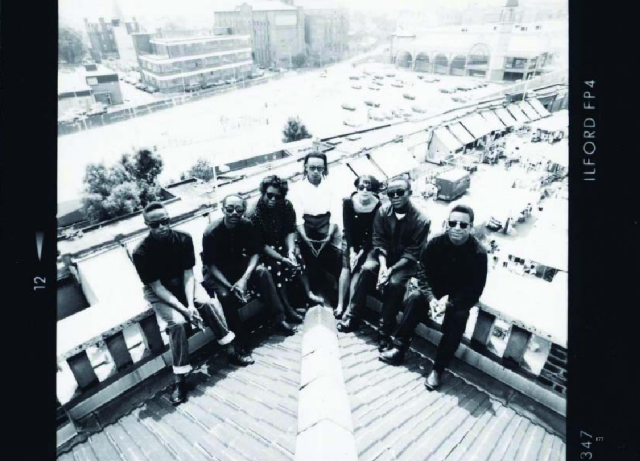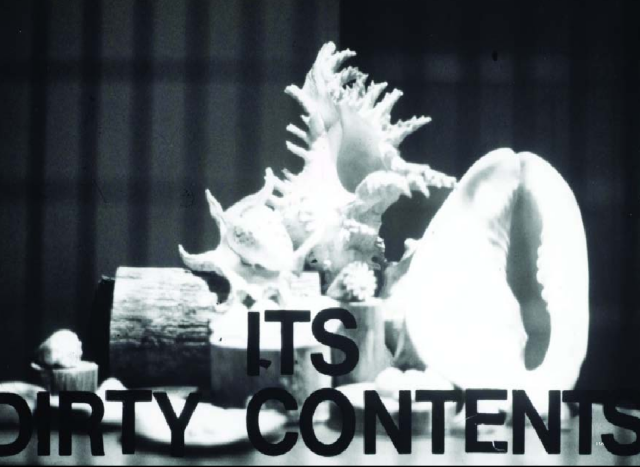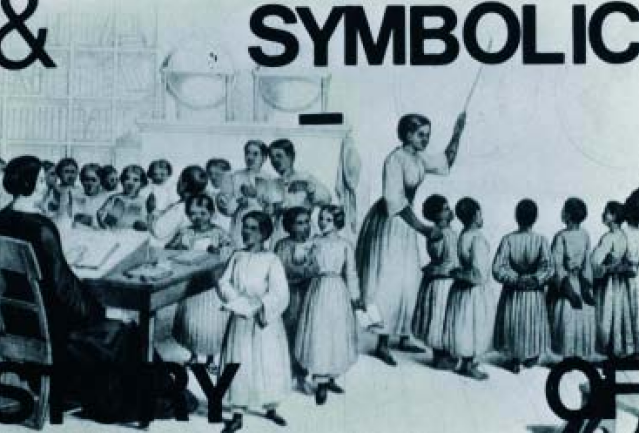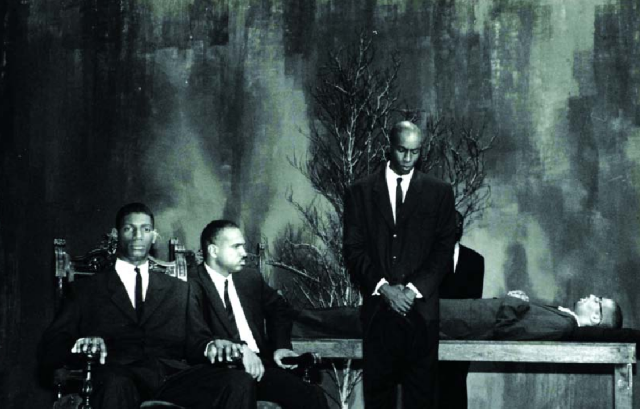Black Grammatology
Initially a vital component of experimental black film culture, the Black Audio Film Collective quickly arrived at retrospective respectability. Josephine Berry Slater enters the memory space of their recent show at FACT and retrieves the radical yet 'still born' possibilities from its multi-media memorial
Let them bear witness to the process by which the living transform the dead into partners in struggle, Handsworth Songs, BAFC
I am the sky computer, Lee Perry
In their strongest works, the Black Audio Film Collective (BAFC) precipitated the innate promiscuity of signs to destabilise generations of cultural indoctrination relating to racial and national identity.[1] Within this project, the intention to orchestrate the ‘delirium of becoming’ through the exposure and upending of stereotypical representational codes comes into conflict with the group’s other aim of nurturing a specifically ‘Black’ independent film culture. The fabricative freedom of semiotic experiment and identitarian ambiguity, and the narrative coherence of black history making, then, represent the contradictory poles of BAFC’s practice.
Given the group’s activist dedication to sharing their knowledge of film history, practical techniques and deconstructive theoretical approaches with working class audiences through workshops and screenings in the 1980s, it is a little depressing to find that the gallery has become the principal home for this once avowedly democratic film culture. Ghost of Songs, a touring retrospective of BAFC’s oeuvre, opened at FACT in Liverpool (itself a former grass-roots organisation now willingly engaged as a flagship organisation of Liverpool’s vigorous cultural regeneration). However, this sense of a general waning of independent film culture – bound up as it is with the increased commercialisation of television, digital technologies’ atomisation of the so-called public sphere and the squeeze this has placed on the economic viability of fringe venues – did not detract from the pleasure of viewing (nearly) the full wealth of BAFC’s achievement in one sitting.

Image: Members of the Black Audio Film Collective
Against a backdrop of riots occurring across Britain in the late ‘70s and early ’80s, monumentalised by the names of the districts in which they occurred – Southall, Toxteth, Brixton, Handsworth, Tottehham – the BAFC chose not to make flatly propagandistic films designed to quicken the insurrectionary pulse of the times, but ones which rather cleared a space for reflection, memory, mourning and becoming. Although dealing with contemporary events such as oppressive policing, inner city ghettoisation and the clearing and destruction of working class enclaves (London’s Docklands), they were also responding to a more fundamental condition of the victims of colonisation and slavery – the ‘absence of ruins’; a phrase they took from Caribbean poet Derek Walcottt.
This is one explanation for their use of the slowed down medium of ‘tape-slide’ or ‘slide-film’ in their early performances; a technique which promoted a space for and feeling of memory inside the film as well as outside. The technique involved projecting a sequence of collaged 35mm slides and slowly dissolving one into another against a soundtrack of looped (spoken, reggae and industrial) sounds. As Kodwo Eshun, member of the show’s curators the Otolith Group, describes in the catalogue, ‘Standing at long tables, they would layer a gel, then pass it on to the next person who would add or subtract another gel until all were satisfied with the result.’[2] The result was the creation of multiply layered images which denatured the residual naturalness and ‘self-evidence’ of photography, and produced an experience somewhere between the meditative act of looking at a photograph and the affectiveness of cinema’s temporality.

Image: Black Audio Film Collective, Images of Nationality
Their two part tape-slide work Expeditions (1982-84), comprising the pieces Signs of Empire and Images of Nationality, exercises a curious relationship to the intended potency of empire’s iconography. Without denying the fascination and possibly even attraction the photographs, architecture and statuary of the colonial past sometimes hold for us, Signs of Empire – on display in Liverpool in its own hushed felt-lined room (designed by Tanzanian born architect David Adjaye) – disturbs the images’ natural habitat and the target of their seduction. Divorced from their singular occupation of an intended context, space and time, photographs of allegorical statues celebrating the gift of the colonies, starchy family scenes flanked by native servants, or others forensically displaying the punitive mutilation of the colonised, relate to one another as the visually declined grammar of a total system. Where these images were made principally by and for the colonisers, to be experienced in predefined ways and places, to celebrate their triumph over black subjects and distant lands, when displaced and re-assembled in this way the power of representation and signification is wrested out of the hands of the powerful. This is the BAFC’s early answer to the representational disenfranchisement of the colonised, the consequent absence of ruins, and the black diaspora’s subjection to years of introjected cultural inferiority.

Image: Black Audio Film Collective, still from Signs of Empire
The malleability of film and recorded sound both make this displacement and redeployment within a revealed grammar of oppression possible. The superimposition of words and phrases also helps to create this effect. Somewhat reminiscent of the word/image combinations of childrens’ books, the wording creates a sense of disrupted and disruptive pedagogy; phrases like ‘The hinterlands of narrative’ and ‘the impossible fiction of tradition’ create a conceptual tool-set whilst negating the authority of cultural coding per se. The sounds and images that populate Signs of Empire resonate intensely; many pairs of eyes stare back at us from across centuries and are dilated, made unenigmatic and then enigmatic again, by repetition, superimposition and looping. ‘If you look at their faces … I think they don’t know who they are or what they are. And really what you’re asking me is how the hell one gives them the sense of belonging’. This comment, made by Sir Ronald Bell QC on the BBC’s documentary series Panorama, is looped in small snatches, throughout Signs of Empire. ‘They don’t know who they are or what they are’, ‘If you look at their faces’, ‘Who they are or what they are’ recurs hypnotically against a trance like soundtrack, until the originally contemptuous statement is adulterated into an empowering refutation of identity. As Eshun states in the catalogue, the phrase becomes a mantra that ‘amplified the incapacity of authority to locate subjects whose very presence constituted an irksome reminder of post-imperial malaise.’[3]
This now quite distant seeming moment of self-conscious yet not self-righteous black cultural self-reinvention was motivated by the desire to lift off from the mainstream without abandoning working class people. BAFC’s high degree of formal experiment and style was nevertheless combined with an indefatigable dedication to creating new black practitioners and audiences of film through teaching, screenings and workshops. This sense of experiment allows one to look at a displayed flyer for an event at East London venue Four Corners which stipulated ‘Blacks only admitted for screening 4’ without fearing the essentialisms of a black nationalist agenda. If anything, such a screening – possibly one of only a handful – seems experimental and transitional given the films the BAFC were making at this time in the mid ‘80s. Without proferring an agenda for what black cinema should be, one can only imagine that the screening hoped to provoke discussions afterwards deemed impossible between mixed race audiences. A restriction employed to trigger a relaxation of speech and expression rather than the insistence on a shared identity?
It would be wrong to downplay the extent to which BAFC were operating within and responding to the terms of contemporary racism and raciology. Perhaps this is most clearly articulated in their best known film Handsworth Songs, directed by John Akomfrah in 1986 in the wake of the riots in Handsworth, Birmingham, that had occurred the previous October. This film represents a shift from the tape-slide method to ‘straight’ cinema, but continues the mnemonic treatment of sound and image through the use of archival material, loops, slowed down speeds, and repetition. However this film belongs far more resolutely to an historical moment in which the film-makers were also caught up; a moment which saw an outpouring of rage over the systematic persecution and neglect of black immigrant communities living in de-industrialised urban wastelands. Handsworth Songs allows people in the riot’s immediate aftermath to articulate their sense of what had happened and why. Without a synthetic analysis or narrator’s guiding hand, and without the audience even being able to determine which footage had been shot by news media and which by the film-makers, the film is comprised largely of terse and off-the-cuff statements by residents about the riot. All agree that, contrary to news reports, it was not a ‘race riot’ between Afro-Caribbeans and Asians, but beyond this the ‘meaning’ of the event remains uncertain.

Image: John Akomfrah, Soho Road, Handsworth, Birmingham © Pogus Caesar / OOM Gallery Archive 1985
Far from being ‘senseless’, as a looped and slowed-down bit of news reporting records Douglas Hurd concluding to himself on an official visit to Handsworth, the multiple statements which layer meaning and interpretation, overwhelmingly construct the sense of the riot. A background of intensifying antagonism between police and the local community emerges – the chief inspector of Handsworth had accused the community of drug pushing and 650 people had been arrested over two weeks that July. Different voices describe deliberate provocation by the authorities: ‘they are putting us in a corner’; ‘if we is right we is wrong, and if we is wrong we is double wrong’; ‘white residents complained about hard drugs … but you don’t get rastas flying over to Pakistan, it’s businessmen in suits pushing heroin.’ The film also gives a sense of the elation of power reversal and of being on the brink of something bigger: ‘The only time I saw police run, or terror in the eyes of people responsible for the way the ghetto is, was on that Monday night.’ But any sense of a revolutionary escalation is consistently tempered by the spectre of the power brokerage that must surround such events and the need to reformulate them within the terms of conventional politics. We see the beginnings of the ineptitude that will culminate in the impasse of state managed multiculturalism in millennial Britain. A group of sikh community leaders say that ‘earning money’ is a long-term strategy for peace, while an astute young Asian man ridicules official attempts at passifying young people, ‘Youth are being given sports facilities – it’s ludicrous to think youth will spend 24 hours a day playing sports.’
The bitter reality of life in Britain for immigrants from the former colonies is heightened by the inter-spliced footage of Caribbean migrants disembarking from boats in what could be Liverpool in the 1950s. Formally dressed in colourful, pristine summer clothing, gloves and distinctly un-British straw hats, or sitting demurely whilst having pictures taken, the collective optimism of these young men and women is both palpable and, with hindsight, tragic. Some black and white footage of a pretty, fashionable young teenage girl working a metal press in harsh industrial surroundings (and by implication dreaming of somewhere else) encapsulates the betrayal of her generation’s hopes. Some of the footage of Caribbeans getting off boats is used again in Akomfrah’s later film Touch of the Tar Brush, but by this point the film-making has become more conventional and the archival footage merely illustrative. Handsworth Songs feels like the collective’s sylistic midpoint, poised between their early semiotic deconstruction and their later highly narrative documentaries and biopics. By contrast to these later films in which archival footage, interview material and conventionally symbolic sequences combine into the synthetic structure of historical analysis or documentary thesis, Handsworth Songs feels like the poetically absorbed aftershock of an event whose fault lines chase the broken pieces of history, film and film’s own history backward and forward in time. The film begins and ends with the footage of a black guard admiring a large fly wheel in an unspecified museum of industrial history. This wheel can be read as a symbol of the eternal return of the past in the future; the expropriated labour of the guard’s slave ancestors, transferred into the dead labour stored up in the machine itself. But also, as the narrator confirms, in the movement by which ‘the living transform the dead into partners in struggle’. The ambivalent figure of the uniformed guard, who admires the ‘open mindedness’ of the men who built the machine, stands for the compromised position of the outsider who must seek acceptance, while the film as a whole gives the lie to any delusion of reciprocity or equivalent respect at the hands of the British. Colonial powers continue to re-enslave post-colonial subjects in their metropolitan hearts, but here the photographic traces of the colonial dead rise up to join the living in their fight. The film acts as a field for the enactment of transhistorical struggles whose conclusion is troublingly unknown.

Image: Opening of Testament at the Ritzy Cinema
Given the artistic success of these early films, it is difficult to comprehend how the BAFC moved so resolutely from a deployment of the syntagmatic and paradigmatic to the symbolic ‘imagination of the sign’, to quote from Roland Barthes, an important influence on the collective.[4] While contesting society’s dominant raciology, their early films also treated it as a system of interconnecting signs whose efficiency was grammatical and contextual as much as it was symbolic or affective. Within this there is always the question of the film-makers’ own personal experience of racism and subjective inhabitation of a produced raciology. Undoubtedly they positioned themselves proactively as black film-makers, sought out all black audiences etc., yet the form of their work registered an acute understanding of the ‘fabricative’ power of semiotics – to unmake and then make (identity) again. This power not only denaturalised and hence weakened colonial codes, it also projected the possibility of forging new codes for the future. Later, however, in films like Mysteries of July, (Reece Auguiste, 1991), A Touch of the Tar Brush (John Akomfrah, 1993) and Seven Songs for Malcom X (John Akomfrah, 1993), while treating many of the same issues, the films begin to lean heavily on a symbolic treatment whose meaning is overly fixed and whose register is largely emotional.

Image: Black Audio Film Collective, still from Seven Songs for Malcolm X
The iconography of candles and flowers, for instance, are deployed in Mysteries to create a ‘gallery of mourning’ to commemorate the deaths of black men in police custody. Funereal iconography is carried over into Seven Songs for Malcom X as first his father and then Malcom X himself are filmed laid out and surrounded by mourners in a tableau vivant, their respective deaths at the hands of the Ku Klux Klan and alleged Nation of Islam assassins forming the pivotal events of the film. The over-coded and clichéd symbolism combined with the heavy focus on the psychological dimensions of historical figures which adheres to biopic conventions, subdues the viewer into a conventional and passive engagement. By the ‘90s BAFC’s films were being commissioned and made principally for TV, a context change which seems to have brought with it the demand to make films which could inhabit, though sadly not challenge, popular conventions of film-making.

Image: BAFC after winning The Grierson Award
In one of their last films, The Last Angel of History (John Akomfrah, 1996) the exploration of the fertile territory of Afro-futurism, the musical cultures of the African diaspora, and the potential of digital code to blur boundaries (between musical genres, historical moments, identities etc.), is sadly stultified by the film’s adoption of the film essay technique. Interviews of talking heads (including critics, DJs and musicians such as Kodwo Eshun, George Clinton, Greg Tate, Lee Perry and DJ Spooky, and the first black astronaut, Guion Bluford) in either professional settings or in ‘professionally’ lit studio environments, are cut together with footage from film and musical performances. The only shift from the factual or artefactual comes with the film’s adoption of an allegorical figure, ‘the data thief’, who wears shades (presumably to protect him from the blinding light of the future) and is featured either looking out across post-apocalyptic landscapes or ‘inside’ the computer.

Image: The Data Thief from The Last Angel of History Black Audio Film Collective, 1995
The alterity of a few clips from Sun Ra’s film Space is the Place, or of Lee Perry dancing around with a mirrored headdress chanting ‘I am the sky computer’ assures one that, by contrast, The Last Angel of History cannot be counted among the code stretching, genre warping tradition of Afro-futurism itself, but rather among the forces of documentation, explanation and history making. Given BAFC’s early psychic surgery on the deeply inculcated dominant semiotic order, the failure to explore the ‘digital imaginary’, to participate in the self-reflexive exploration of technology, identity and futurity that the film’s literal content celebrates is highly disappointing. In his discussion of the role played by music technologies in developing black urban music, Kodwo Eshun praises the unwordliness of the sounds they produce. This music isn’t reminiscent of the street, of urban experience, of anything locatable; instead the music of the studio is ‘impossible imaginary music’. Whatever one thinks of the truth of this statement, Eshun’s desire for the creation of new cultural life forms is inspiring. For a brief but enduring moment, BAFC achieved this in films like Signs of Empire and Handsworth Songs. But Ghost of Songs, like Benjamin’s angel of history itself, assembles a body of work which faces the past not the future. Although its movement is ultimately defined by history’s victors – the forces of commercialisation and normativity – it also keeps alive the hope that at any moment its stillborn new beings will re-join the living in struggle.
Info
The Ghost of Songs: A Retrospective of the Black Audio Film Collective was at FACT, Liverpool, 02 February - 01 April 2007 and will be touring several UK venues throughout 2007.
Notes
[1 ] The Black Audio Film Collective was formed in 1982 by a loose group of friends studying Sociology and Fine Art at Portsmouth Polytechnic: John Akomfrah, Reece Auguiste, Edward George, Lina Gopaul, Avril Johnson Trevor Mathison and Claire Johnson who left in 1985 and was replaced by David Lawson.
[2] Kodwo Eshun, ‘Drawing the Forms of Things Unknown’, The Ghosts of Songs: The Art of the Black Audio Film Collective, Liverpool University Press, Liverpool, 2007, p.80.
[3] Ibid
[4] See Roland Barthes, ‘The Imagination of the Sign’ in A Roland Barthes Reader, London: Vintage, 1993. For Barthes signs have three modes of relation: symbolic, paradigmatic and syntagmatic. The symbolic is a ‘depth model’ referring to the sign’s signified. The paradigmatic describes the ‘homological relation’ of the sign to its ‘virtual brothers’, how it refers to ‘a reservoir’ of forms from which it is distinguished by the smallest difference – such as the endings of a declined verb. The last refers to the sign’s highly mobile relation to its network of actual neighbours, uniting signs ‘on the level of discourse itself’, ‘whose combination produces meaning, or more generally a new object’.
Josephine Berry Slater <josie AT metamute.org> is Editor of Mute
Mute Books Orders
For Mute Books distribution contact Anagram Books
contact@anagrambooks.com
For online purchases visit anagrambooks.com






